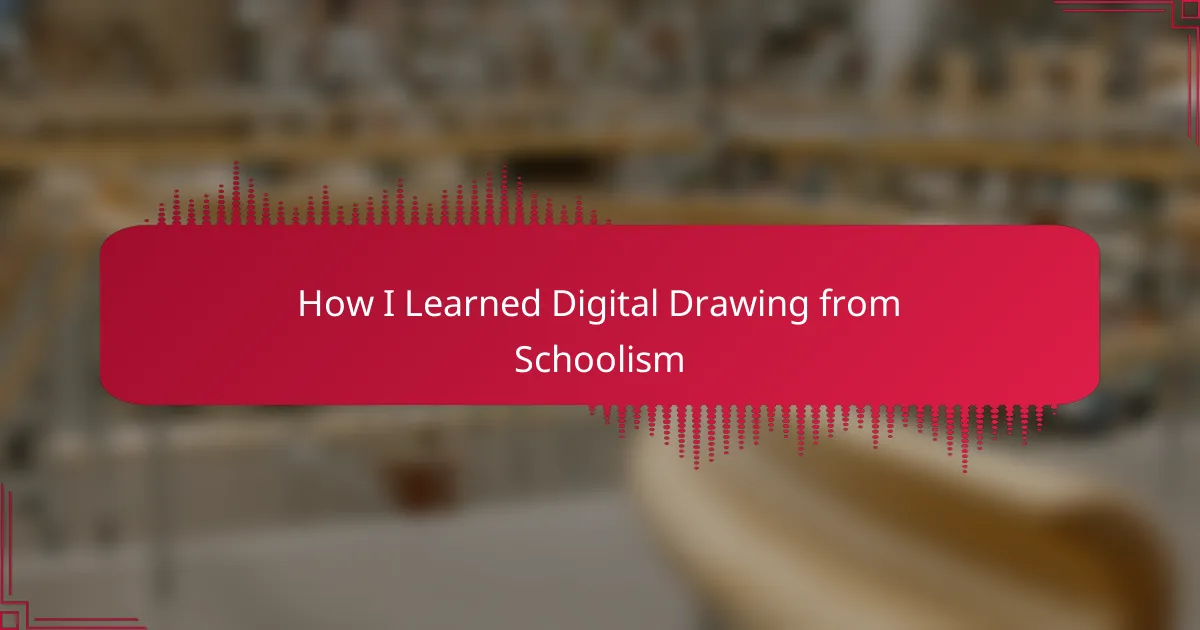Key takeaways
- Digital drawing combines traditional techniques with modern technology, allowing for endless experimentation and creativity.
- Online resources, such as Schoolism, offer valuable courses that enhance skills in digital art and storytelling.
- Interacting with a supportive community and receiving constructive feedback can significantly boost motivation and artistic growth.
- Key techniques learned, like effective use of layers and color theory, greatly enhance an artist’s ability to express emotions and narratives visually.
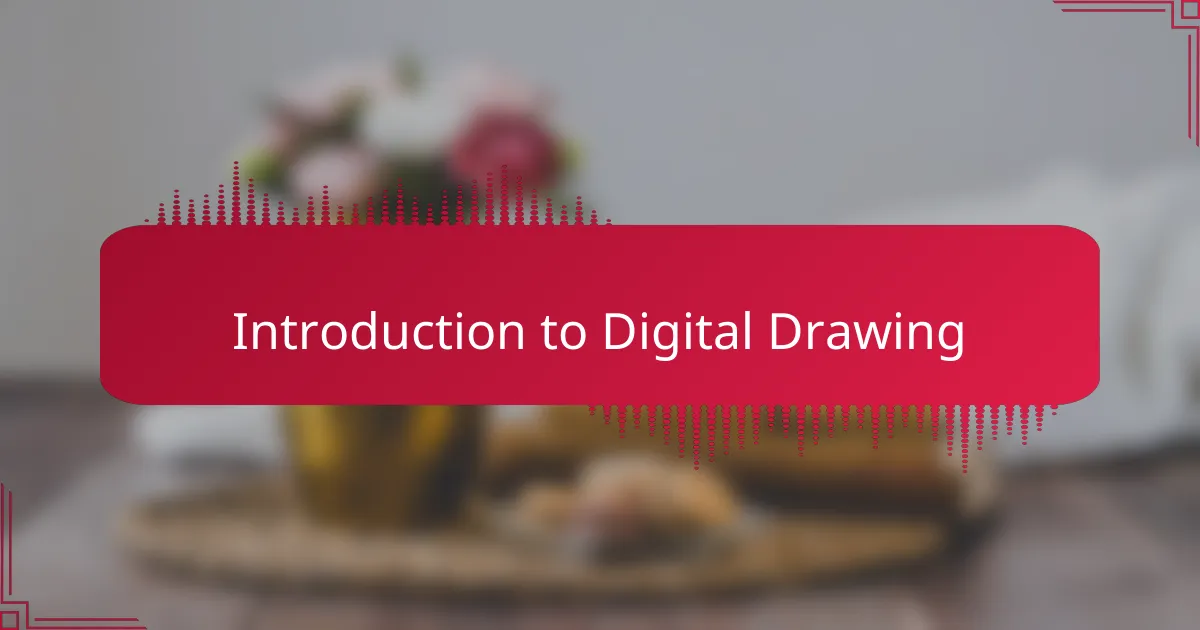
Introduction to Digital Drawing
Digital drawing has become a transformative tool for artists like me, as it combines the timeless craftsmanship of traditional techniques with the advantages of modern technology. I still remember my first hesitant strokes on a tablet; the experience was oddly exhilarating yet intimidating. Have you ever felt that blend of fear and excitement when trying something new?
As I delved deeper into the realm of digital drawing, I found it incredibly freeing. The ability to experiment without the fear of wasting supplies rearranged my creative process. It was like stepping into an infinite canvas where I could make mistakes, undo them, and keep pushing boundaries.
Learning digital drawing is not just about mastering software; it’s about exploring your unique style. I often ask myself, “What can I create today that I couldn’t do yesterday?” This question has driven me to continuously evolve my skills and express my artistic voice. It’s this journey of exploration that makes digital drawing not just a skill, but a passion.

Resources for Comic Book Authors
When I first started exploring resources for comic book authors, I stumbled upon a treasure trove of online courses. Platforms like Schoolism offer incredible classes that range from digital drawing techniques to storytelling fundamentals. Have you ever taken a course that sparked a new level of creativity in you? For me, these classes were game-changers; they provided structured learning while letting me connect with fellow aspiring artists.
Another great resource is community forums and social media groups specifically tailored to comic book authors. Engaging with like-minded individuals not only helped me find answers to my burning questions but also fueled my motivation. I vividly remember sharing my work and receiving constructive feedback, which ignited a fire in me to improve faster than I expected. Isn’t it amazing how a supportive community can push you to reach your full potential?
Books dedicated to the craft of comics are another invaluable resource. I’ve found that diving into the theoretical aspects—understanding panel layouts, pacing, and character development—has significantly enriched my storytelling skills. One book that really resonated with me was “Understanding Comics” by Scott McCloud; it opened my eyes to the mechanics behind the medium. What about you? Have you discovered any gems in literature that transformed your approach to comic book creation?
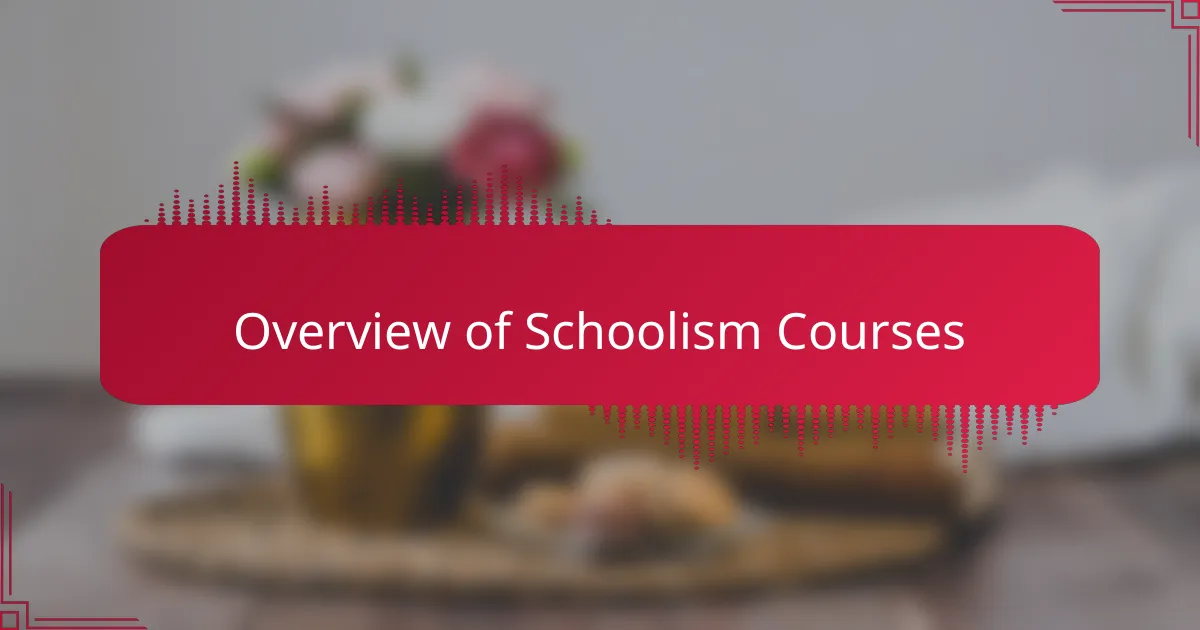
Overview of Schoolism Courses
When I first discovered Schoolism, I was captivated by the variety of courses they offered. Each class felt like a unique adventure, whether it was focusing on character design or mastering color theory. The lessons came alive with inspiring insights from industry professionals, making me realize that digital drawing could be both a skill and an art form.
The courses cover a wide range of topics that cater to different skill levels and interests. Here’s a snapshot of what you can expect:
- Fundamentals of Digital Painting: A deep dive into basic techniques and getting comfortable with software.
- Character Design: Learn how to create memorable characters that resonate with readers.
- Storytelling through Art: Understand how visuals can enhance narrative storytelling in comics.
- Portfolio Development: Tips and guidance on crafting a standout portfolio to showcase your skills.
- Animation Basics: Introducing the principles of animation for comics that come to life.
These courses genuinely changed my approach to digital art and writing, sparking a creative fire I didn’t know existed.

Benefits of Online Learning
Online learning has transformed the way I approach skill-building, especially in fields like digital drawing. When I enrolled in Schoolism, I was amazed by the flexibility it offered. It allowed me to learn at my own pace, which was a game-changer for someone like me, who thrives in an environment where I can revisit lessons and practice more intensively when inspiration strikes.
One particular aspect that I appreciate about online learning is the opportunity to connect with a global community of artists. Interacting with peers from different backgrounds not only broadened my perspective but also inspired me to explore styles outside my comfort zone. I vividly remember sharing my work in forums and receiving constructive feedback; it was both nerve-wracking and exhilarating.
Benefits of Online Learning:
- Flexibility to learn at your own pace and schedule your study time.
- Access to world-renowned instructors and a diversity of teaching styles.
- Opportunities for real-time feedback from peers and mentors.
- Immediate access to a rich library of resources and recorded lectures.
- A supportive community of learners that motivates and inspires creativity.
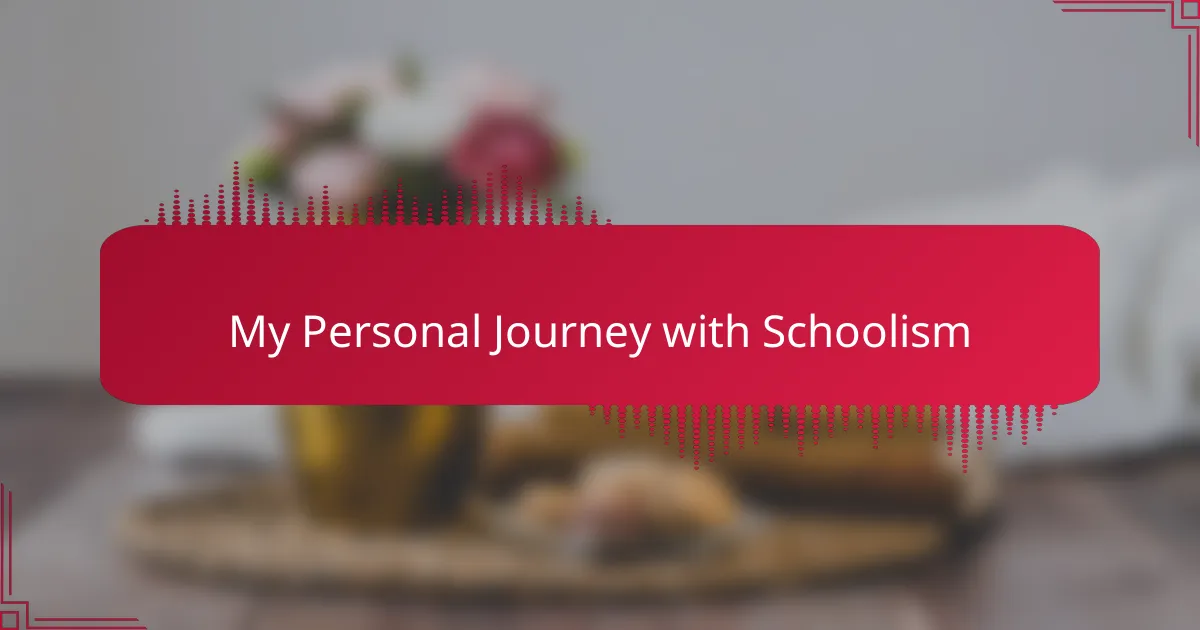
My Personal Journey with Schoolism
As I ventured into Schoolism, I was immediately struck by the vibrant community. It wasn’t just about the courses; it was the sense of belonging that truly captured me. I fondly remember participating in live critiques, where my heart raced with every comment on my work. Isn’t it amazing how sharing your art can create such an electric atmosphere?
Some of the most enriching experiences came from the interactions with my instructors. They shared not only technical skills but also personal stories that resonated deeply with my own artistic struggles. I recall a particular moment when one of them spoke about overcoming creative blocks. It felt like an unspoken bond forming amongst us all, where vulnerability became a source of strength.
One standout memory was completing my first project under Schoolism’s guidance. The sense of accomplishment I felt was beyond words. I had taken a rough idea and developed it into something tangible, something I was truly proud of. Have you ever experienced that rush where you realize you’ve grown, even if just a little? Schoolism guided me through that exhilarating process, and it changed how I viewed my potential as an artist.
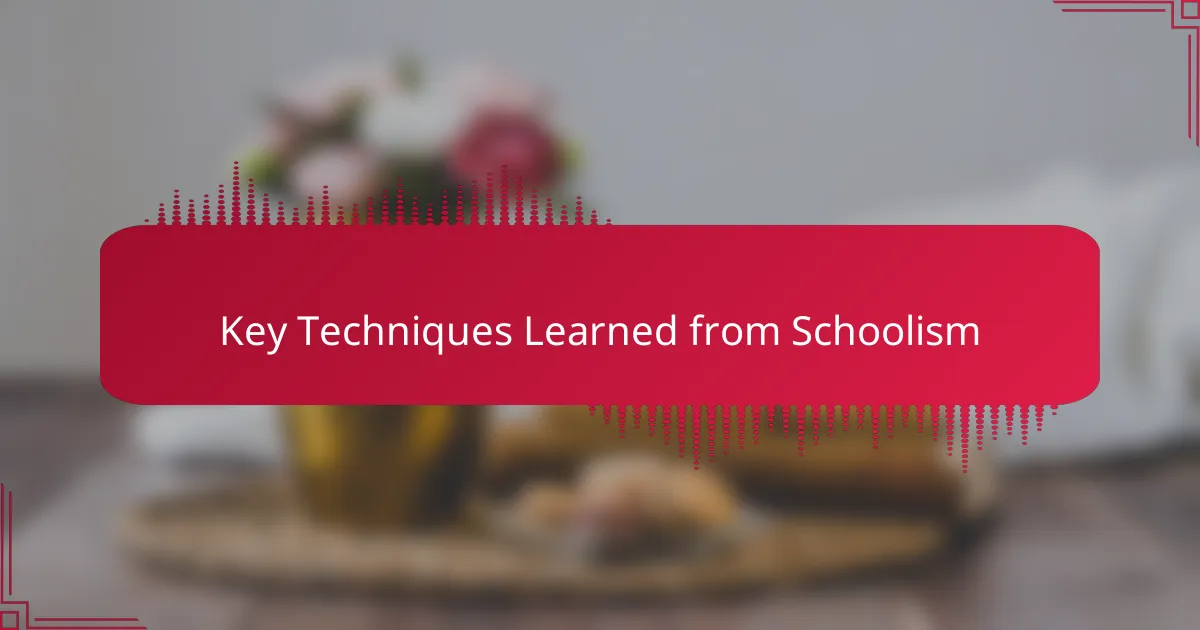
Key Techniques Learned from Schoolism
The technical skills I gained from Schoolism were integral to my development as a digital artist. One of the techniques that stood out was understanding the use of layers effectively in my digital drawing software. I remember my confusion during my early attempts, often merging layers too soon and losing important details. Once I grasped the concept of layers, it was as if someone turned on the lights in a dark room. I could experiment freely, making corrections without the fear of erasing hard work.
Color theory was another eye-opening revelation for me. During one particular lesson, I learned how colors interact and the emotional responses they evoke in viewers. It was fascinating to realize how much a palette could alter the mood of an entire piece. I often find myself questioning how color choices affect my storytelling. What about you? Have you ever looked at a piece of art and felt an emotion purely because of its colors?
Furthermore, the emphasis on storytelling through art was a game-changer. Looking back, I can still feel the thrill of learning how to weave narratives visually, making each panel work harmoniously with the words. That moment when I realized my pieces could convey subtle emotions without dialogue was transformative. It opened my eyes to the depth of expression in graphic storytelling, merging visual art with literature in a way I had never considered before. Isn’t it incredible how much power an illustration can hold?
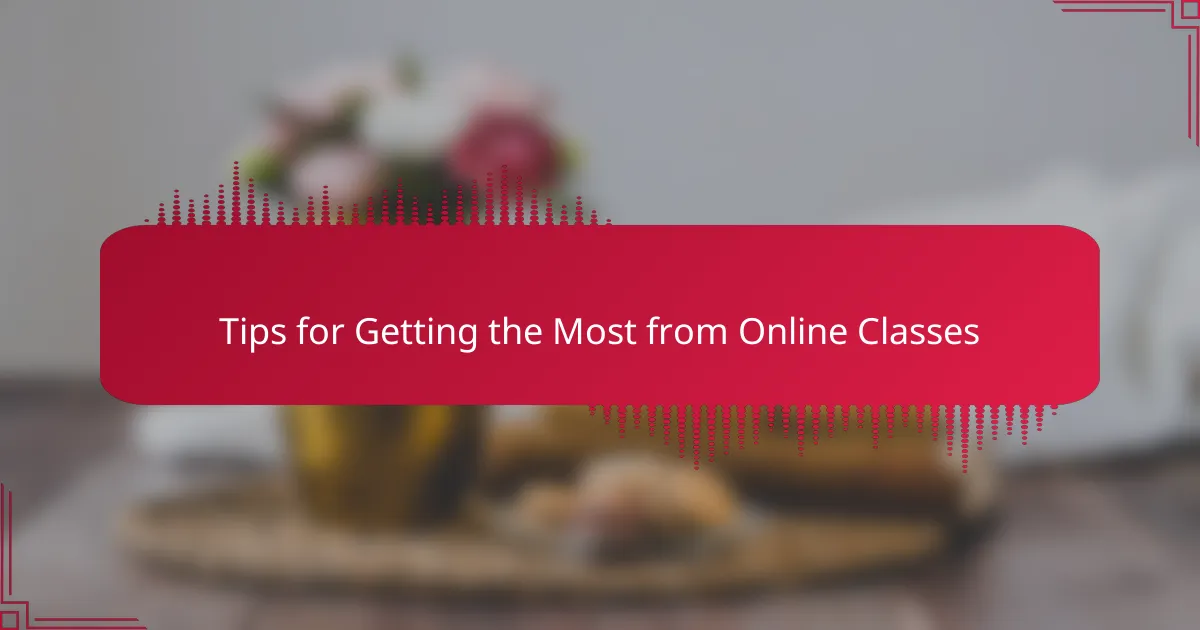
Tips for Getting the Most from Online Classes
Taking online classes can sometimes feel overwhelming, especially with the wealth of information available. From my experience, one of the best tips is to create a dedicated space for your learning. It’s amazing how much more focused I became once I set up a little corner of my home for drawing—it turned into a sanctuary where I could really immerse myself in the lessons.
Additionally, staying engaged is crucial. I found that actively participating in discussions and critiques made the learning experience so much richer. It wasn’t just about watching the videos; it was about connecting with others who shared my passion for digital art.
Lastly, setting small, achievable goals helped me immensely. I remember setting daily drawing challenges that not only reinforced what I learned but also kept my motivation high. It’s those little steps that added up to significant progress over time.
| Tip | Description |
|---|---|
| Dedicated Space | Create a specific area for learning to minimize distractions. |
| Engagement | Participate in discussions and critiques to enhance understanding. |
| Small Goals | Set daily challenges for consistent practice and motivation. |
